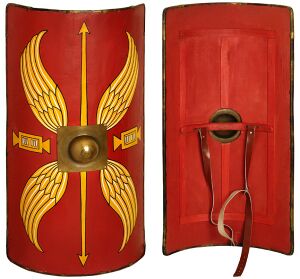Shield

Straddling the line between body armor and weapon is the shield. A shield is a hand held barrier used to deflect or otherwise stop incoming blows. Usually a shield would be carried in the user's secondary hand while the favored hand would carry a weapon (the right hand in most cases). Shields have been in use since at least the neolithic period, and have been used by people from Europe to Australia to the Americas. Shields have been constructed from a variety of materials, including woven reeds, animal hides and textiles over frames made of wood, bone, or metal.
Shields in Warfare
One of the most effective ways for infantry to make the most of shields was to stand shoulder to shoulder, forming a shield wall. This way each guy protects not only himself, but the people to his sides which will have to go through him to get around their shields and vice versa.
In addition to defense, shields can also be used offensively. A good solid shield is a broad heavy object, it can be used to bash people to disorient them, thus allowing the killing blow to be dealt. The Romans were very fond of this. Some forms of shield had spikes added to them in order to make the most out of bashing attacks.
Types of Shields
- Buckler: The smallest of the shields, no bigger than 6-18 inches in diameter and light enough to be held in one fist. It was too small to block arrows and projectiles, but its light weight made it excellent for protecting the sword hand and deflecting an enemy's weapons in melee combat. It could also double as a punching weapon. The term "swashbuckler" comes from the rather theatrical fighting style employed by the swordsmen who favored fighting with a sword and buckler.
- Heater Shield: Named by Victorian antiquarians for their similar shape to a clothes iron, heater shields were relatively light while still providing a fair degree of protection, making them an ideal form of protection when paired with a sword. (This is the shield most people think of when they think of a sword-and-shield combination.) Later versions had small notches just large enough for the user to place his lance on it as a guide while jousting.
- Scutum: A massive shield almost as large as a man's body that was the mainstay of the Roman legions. These were often used alongside a javelin and gladius to either charge at an opponent or to provide cover when throwing javelins. A particularly favored formation that utilized the scutum was the testudo (literally "tortoise")- the soldiers on the front and sides of the formation would hold their shields outward, while the remainder would overlap their shields above the heads of the formation, creating a box over themselves which was invaluable in siege warfare for its ability to block attacks from all sides.
- Targe: A relative of the buckler developed in Scotland, targes are round shields about 18-21 inches in diameter with two loops on the back- one for the arm to pass through and another to be held in one's hands, essentially allowing the wielder to have some degree of protection even while wielding a two-handed weapon (e.g. a claymore). The center of the shield was frequently equipped with a large spike, making it fairly effective as a weapon on its own as well. (Fun fact- the term "target" is derived from the general size and shape of the targe.)
- Kite Shield: A large shield with a distinctive upside-down teardrop shape which allowed users to guard both the forelegs and the upper body. As body armor became more prevalent (thus minimizing the need for leg cover), it was eventually superceded by the heater shield.